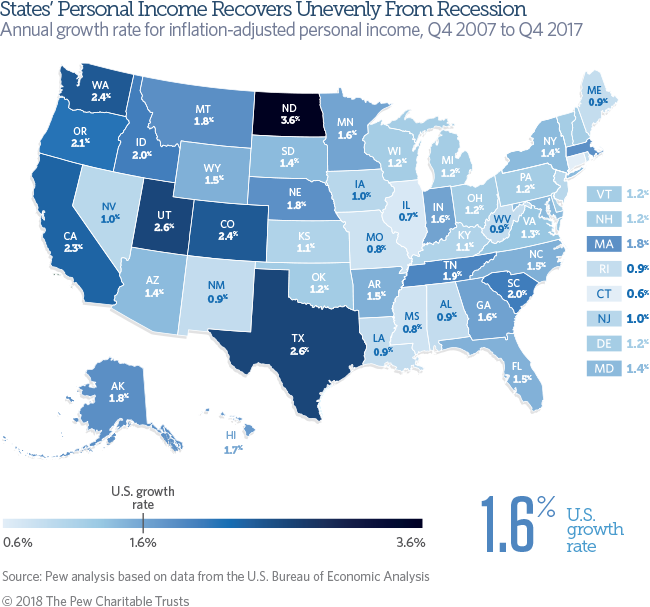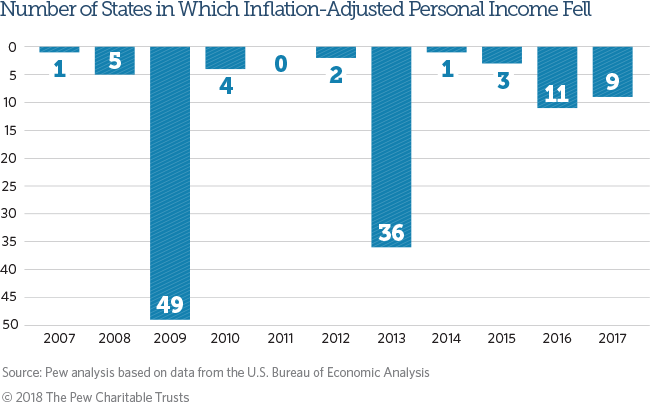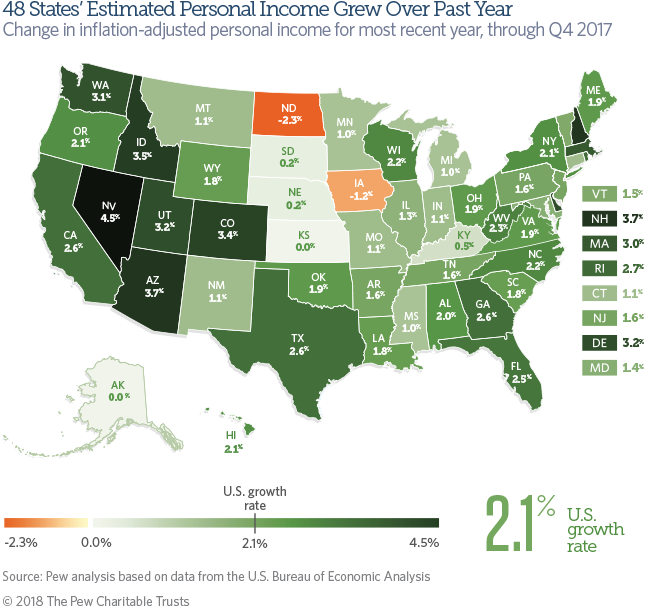Connecting state and local government leaders
All three major components of personal income—work earnings, transfers such as Social Security benefits, and property income—rose over the past 10 years. Among the factors that shape personal income, effects vary by state.
This article was originally published by The Pew Charitable Trusts' States' Fiscal Health initiative and was written by Barb Rosewicz, Ruth Mantell, and Joe Fleming.
Since the Great Recession hit the U.S. a decade ago, the economy's slow recovery has played out unevenly across states. Growth has been fastest in North Dakota, where the sum of all residents’ total personal income expanded at six times the rate of last-place Connecticut. It took until 2015 for the final state, Nevada, to regain its personal income losses, after accounting for inflation.
Personal income growth has been uneven over the past decade, tumbling in almost all states in 2009, during the depths of the recession, and falling in most states in 2013 after taxpayers shifted income to avoid a potential federal tax hike. Sluggish growth in 2016 and 2017 reflected personal income drops in a number of states.
Reflecting these yearly changes, personal income growth for the period lagged its historical pace. National personal income rose by the equivalent of 1.6 percent a year from the fourth quarter of 2007 through the fourth quarter of 2017, compared with the equivalent of 2.6 percent a year over the past 30 years, after accounting for inflation. These rates represent the constant pace at which inflation-adjusted state personal income would need to grow each year to reach the most recent level.
Only North Dakota, Texas, and Utah have experienced growth since the recession’s onset that matched or beat the historical U.S. pace. In the 10 states slowest to recover, the 10-year expansion was less than the equivalent of 1 percent per year.
Year-to-year changes have been inconsistent over the past decade. Personal income in 48 states—all but Delaware and Kansas—rose more years than it fell. Only eight states saw personal income grow almost every year, falling just once during the throes of the recession.
All three major components of personal income—work earnings, transfers such as Social Security benefits, and property income—rose over the past 10 years. Among the factors that shape personal income, effects vary by state. Transfers, for example, equaled about nine-tenths of the growth in Mississippi, but only one-tenth of the growth in North Dakota. Population growth, which has slowed over this time frame, also can affect a state’s aggregate personal income.
Personal income estimates are widely used to track state economic trends. Comprising far more than simply employees’ wages, the measure sums up all sorts of income received by state residents, such as earnings from owning a business and property income, as well as benefits provided by employers or the government. Trends in personal income matter to state governments because tax revenue and spending demands may rise or fall along with residents’ incomes. However, these statewide sums are aggregates, and should not be used to describe trends for individuals and households.

Trends in Personal Income From the Recession’s Onset in 2007 Through the Fourth Quarter of 2017:
- North Dakota has enjoyed the fastest annualized growth (3.6 percent) since the start of the recession. However, the state’s personal income has trended down for about three years, hit by falling earnings from mining and farming.
- The next-fastest growth since late 2007 has been in Texas and Utah (each at 2.6 percent), and Colorado and Washington (each at 2.4 percent).
- Connecticut’s growth was the slowest of any state since the end of 2007, the equivalent of 0.6 percent a year.
- The next-slowest growth since the start of the recession has been in Illinois (0.7 percent); Mississippi and Missouri (each at 0.8 percent), and Alabama, Louisiana, Maine, New Mexico, Rhode Island, and West Virginia (each at 0.9 percent).
- As companies expanded, wages, salaries, and business owners’ income equaled almost half of U.S. personal income growth over the past decade, with the largest earnings contribution from the health care and social assistance industries. Manufacturing was the leading industry detractor—residents’ earnings from this industry have dropped over the past decade—followed by farming.
- Transfers such as Social Security and Medicare benefits represented about one-third of national personal income growth over the past decade, while property income, such as rent and dividends, made up about 17 percent.

Trends in Personal Income for Calendar Years Beginning in 2007:
Personal income has fluctuated since the recession, which lasted from December 2007 to June 2009. Growth in each calendar year shows the variation that occurred from 2007 to 2017. (See the “Year by year” tab for annual results in each state between calendar years 2007 and 2017.) By contrast, constant annual rates show the steady pace that income would have to rise each year to reach its latest level.
- Delaware and Kansas endured the most frequent drops during the decade—personal income fell in five of 10 years. However, Delaware’s drops were mostly in the first half, while three decreases for Kansas occurred in the most recent five years.
- North Dakota is the only state where personal income has declined in each of the past three years. In another five states—Alaska, Connecticut, Iowa, Kansas, and South Dakota —personal income fell in each of the past two years.
- The fewest decreases—in one of 10 years—were in Colorado, Idaho, Illinois, New York, Oregon, Utah, Vermont, and Washington. Their personal income fell in 2009.
- In 2017, personal income rose in all but nine states: Alaska, Connecticut, Iowa, Kansas, Kentucky, Nebraska, New Mexico, North Dakota, and South Dakota. Weak earnings in industries such as farming weighed down personal income.

Trends in Personal Income for the Fourth Quarter of 2017, Compared With a Year Earlier:
- Looking at recent trends, inflation-adjusted U.S. personal income grew by 2.1 percent in the fourth quarter of 2017 from a year earlier—the fastest pace since the end of 2015 but still below a peak of 4.7 percent at the end of 2014. These results are based on estimates and subject to revision, as is Pew’s ranking of growth rates for state personal income.
- Health care and social assistance made the largest positive earnings contribution to growth. Earnings rose in almost all other industries and fell in farming and utilities.
- Growth was fastest in Nevada (4.5 percent), Arizona and New Hampshire (each at 3.7 percent), Idaho (3.5 percent), and Colorado (3.4 percent).
- Idaho stands out as the only state that has ranked among the five fastest-growing states in each of the last four quarters.
- Personal income fell in two states from a year earlier: North Dakota (-2.3 percent) and Iowa (-1.2 percent), as farm earnings declined.
- Iowa and North Dakota also stand out as the only two states to record year-over-year drops during each of the four most recent quarters.
- In 35 states, personal income growth over the year ending in the fourth quarter of 2017 was stronger than growth since the start of the recession.
What Is Personal Income?
Personal income sums up residents’ paychecks, Social Security benefits, employers’ contributions to retirement plans and health insurance, income from rent and other property, and benefits from public assistance programs such as Medicare and Medicaid, among other items. Personal income excludes capital gains.
Federal officials use state personal income to determine how to allocate support to states for certain programs, including funds for Medicaid. State governments use personal income statistics to project tax revenue for budget planning, set spending limits, and estimate the need for public services.
Growth in personal income should not be interpreted solely as wage growth; wages and salaries account for about half of U.S. personal income.
Looking at personal income per capita or state gross domestic product, which measures the value of all goods and services produced within a state, can yield different insights on state economies. So can looking at household data, which are based on a different measure of income.
Download the data to see state-by-state growth rates for personal income from 2007 through the fourth quarter of 2017. Visit Pew’s interactive resource Fiscal 50: State Trends and Analysis to sort and analyze data for other indicators of state fiscal health.

NEXT STORY: Kentucky’s Deadline Task: Implement an Expanded Sales Tax



